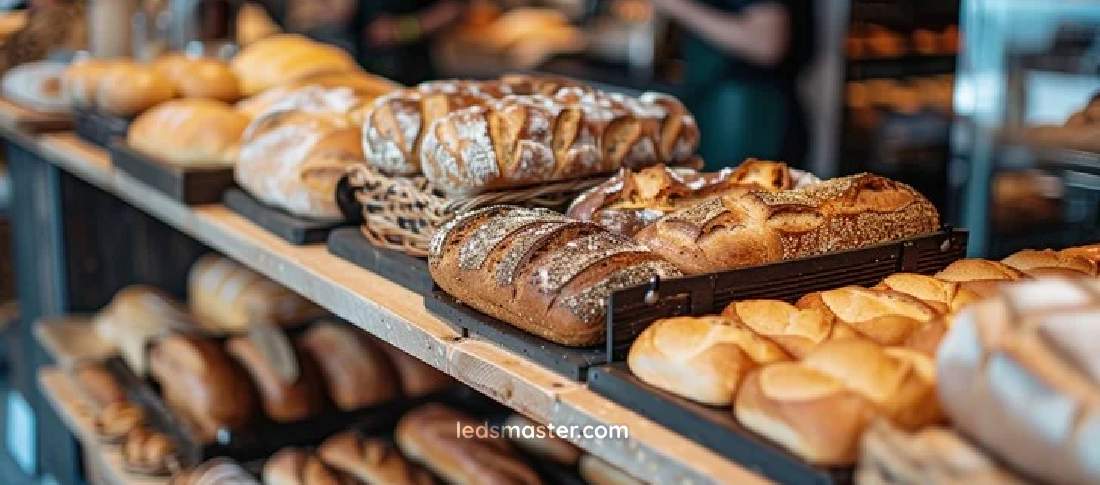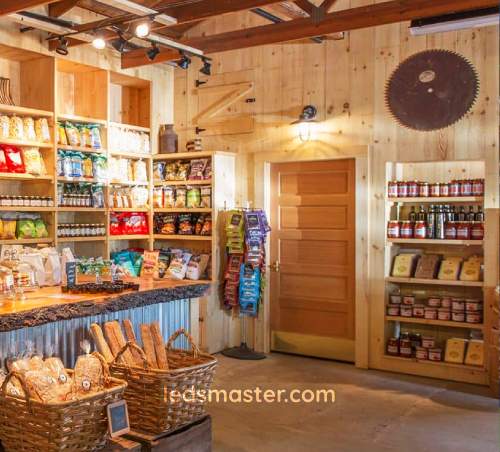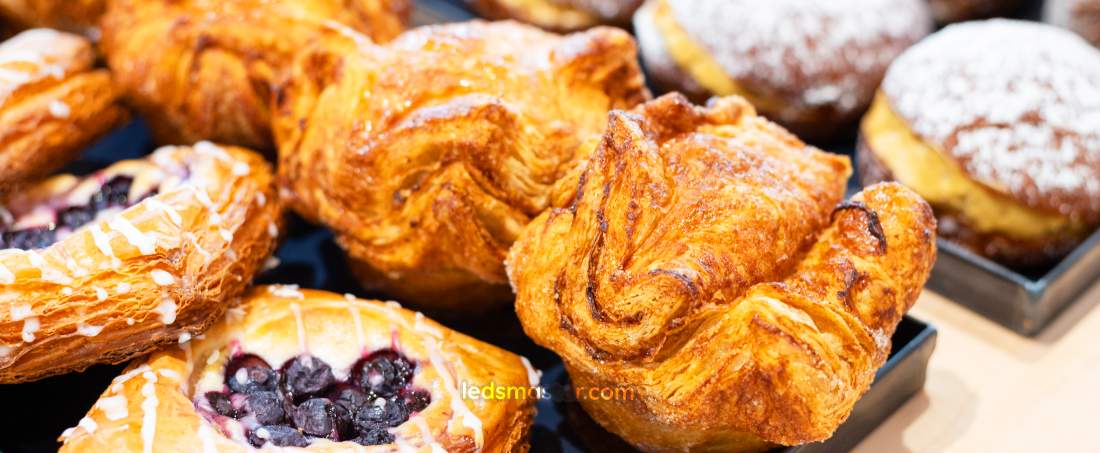Step into our bakery lighting world, where every light is meticulously chosen to enhance ambiance and efficiency. We prioritize creating a safe, inviting environment with lighting solutions that showcase our artisanal products while ensuring the comfort and productivity of our bakers.
From ensuring employee safety to enhancing the presentation of baked goods, effective lighting design directly contributes to a bakery’s success. Proper illumination minimizes hazards, supports efficient workflow, and enhances product display, all while aligning with sustainability goals.
Get your complimentary lighting design today
Table of Contents
ToggleSafety is paramount in bakery environments, where precision and care are essential to both worker well-being and product quality. Proper lighting plays a crucial role in mitigating risks and fostering a safe working environment.
One of the primary functions of bakery lighting is to ensure that all areas prone to accidents, such as spills, wet floors, or sharp equipment edges, are well-lit. Proper visibility is essential to reducing the risks of slips, trips, and falls, which are common in bakery settings where movement is continuous, and the handling of ingredients, trays, and baking tools is frequent. Clear illumination of pathways and work surfaces enables bakery staff to navigate confidently and efficiently, lowering the likelihood of accidents and improving overall safety.
In addition, lighting in areas where ingredients are frequently moved or stored helps to avoid mix-ups or contamination issues. Clear visibility in ingredient storage rooms and preparation zones ensures that each item is correctly identified and handled. By minimizing the risk of accidents through adequate lighting, bakeries can create a safer and more efficient working environment for their employees, which in turn helps maintain productivity and morale.
Bakery equipment, such as ovens, mixers, and proofers, generate substantial heat and require careful handling to prevent injuries. Adequate lighting ensures that equipment controls and warning signs are visible, which is crucial for preventing accidental contact with hot surfaces and operating machinery safely. Well-lit work areas allow employees to operate machinery with confidence, reducing the chance of burns or other injuries associated with hot surfaces or mechanical equipment.
Besides enhancing safety, effective lighting around machinery simplifies maintenance by enabling clear visibility of switches, knobs, and moving parts. Employees can identify potential issues, such as wear and tear or misalignments, before they lead to equipment malfunctions. This proactive approach to maintenance helps reduce downtime, keeping bakery operations running smoothly and effectively.

With advancements in lighting technology, LED lighting has become a preferred choice for bakeries. LEDs offer a range of benefits, from energy savings and durability to enhanced display qualities, making them ideal for the dynamic and demanding environment of a bakery.
 One of the primary reasons for the growing popularity of LED lighting in bakeries is its energy efficiency. LEDs consume significantly less electricity than traditional incandescent or fluorescent lights, translating to reduced utility bills and a smaller carbon footprint. These savings allow bakeries to allocate more resources towards other aspects of their business, such as quality ingredients or customer service initiatives. By adopting energy-efficient LED lighting, bakeries contribute to their sustainability goals, aligning with both environmental stewardship and economic benefits.
One of the primary reasons for the growing popularity of LED lighting in bakeries is its energy efficiency. LEDs consume significantly less electricity than traditional incandescent or fluorescent lights, translating to reduced utility bills and a smaller carbon footprint. These savings allow bakeries to allocate more resources towards other aspects of their business, such as quality ingredients or customer service initiatives. By adopting energy-efficient LED lighting, bakeries contribute to their sustainability goals, aligning with both environmental stewardship and economic benefits.
LEDs also generate less heat than traditional lighting, which further reduces the strain on the bakery’s cooling system. This is particularly beneficial in environments where heat from ovens and other baking equipment can already make temperature management a challenge. The decreased heat output from LED lights helps keep the bakery’s overall temperature more stable, enhancing comfort for employees and customers alike.
LED lights are known for their extended lifespan, often lasting several times longer than traditional bulbs. In a bakery, where uninterrupted operation is crucial, this durability translates to fewer disruptions and reduced maintenance costs. LEDs are also more resistant to vibrations and temperature changes, which makes them well-suited for bakery environments where equipment may produce constant movement or where ambient temperatures can fluctuate. This reliability ensures that bakeries can maintain consistent lighting without frequent replacements, supporting smooth and efficient operations.
By minimizing the need for replacements, LED lights reduce waste and contribute to environmental sustainability. This extended lifespan aligns well with bakery goals to minimize environmental impact while also ensuring stable lighting quality. LEDs offer a resilient lighting solution that stands up to the rigorous demands of bakery operations, maintaining performance and safety over time.
LED lighting not only serves functional purposes but also significantly improves product presentation. LEDs emit a crisp, bright light that brings out the vibrant colors and textures of bakery products, making them more visually appealing to customers. This accurate color rendering is essential in a bakery, where the presentation of goods can influence purchasing decisions. By showcasing the true colors and freshness of items like pastries, breads, and cakes, LED lighting enhances the overall customer experience, encouraging more purchases and promoting customer satisfaction.
Another benefit of LED lights is their minimal heat output, which is crucial in protecting delicate bakery items from heat damage. Products like chocolates, pastries, and cream-filled desserts require careful temperature control to maintain their quality. LEDs, unlike some traditional lighting options, do not emit significant heat, thereby preserving the texture, taste, and appearance of these items. By ensuring that product quality remains high, LED lighting minimizes waste and reinforces a bakery’s commitment to delivering fresh, high-quality goods.

When designing lighting for a bakery, it is essential to strike a balance between functionality and aesthetics. Different areas within the bakery require specific lighting approaches to support both operational efficiency and customer experience.
In the kitchen and preparation areas, task lighting is critical to support detailed tasks such as cake decorating, dough shaping, and intricate pastry work. Task lighting solutions, like under-cabinet LED strips or pendant lights, can be strategically placed to ensure that workstations are sufficiently illuminated. Adjustable lighting fixtures allow bakers to control light direction and intensity, enabling a comfortable work environment that reduces eye strain and enhances precision.
Task lighting also improves overall safety by allowing staff to see ingredients, utensils, and other essential items clearly. With focused light in work areas, bakers can work with greater accuracy and confidence, reducing the risk of mistakes or injuries.
Ambient lighting sets the tone for customer areas, creating an inviting atmosphere that encourages customers to enjoy their time in the bakery. Warm, soft LED lighting can create a cozy and welcoming environment, especially when paired with the bakery’s décor. The ambiance of a bakery significantly impacts customer perception, and warm lighting can make the space feel more comfortable and enjoyable.
Dimmable LED fixtures offer the flexibility to adjust lighting levels throughout the day, accommodating different times of day and enhancing customer experience. For example, brighter lighting may be suitable during busy morning hours, while a softer, dimmed lighting level could provide a relaxed atmosphere in the afternoon. This adaptability ensures that the bakery’s lighting complements the changing needs of the space and the comfort of its patrons.
Accent lighting is an effective tool to highlight bakery displays, drawing attention to featured items such as artisan bread, seasonal treats, or specialty cakes. By using LED spotlights or track lighting, bakeries can enhance the visual appeal of products, making them stand out and enticing customers to make a purchase. Properly positioned accent lighting emphasizes the freshness and beauty of baked goods without overpowering them, creating a balanced display that is both eye-catching and tasteful.
Accent lighting can also be strategically adjusted to focus on specific items based on seasonal promotions or new product launches, ensuring that bakery products are consistently showcased to their best advantage. This attention to display detail reflects positively on the bakery’s brand, reinforcing its reputation for quality and appealing presentation.
Sustainable practices are increasingly important to bakery customers, who often look for businesses that demonstrate environmental responsibility. Lighting choices play a significant role in minimizing a bakery’s environmental footprint, and LEDs are an ideal solution due to their energy efficiency, longevity, and minimal waste production.
LED lighting supports sustainability by reducing energy consumption, lowering greenhouse gas emissions, and minimizing waste due to its long lifespan. Unlike traditional lighting options, LEDs do not contain hazardous substances like mercury, which simplifies disposal and reduces environmental harm. Many LED components are recyclable, contributing further to waste reduction and environmental stewardship.
Switching to LEDs aligns with consumer expectations for environmentally responsible businesses, positioning bakeries as leaders in eco-friendly practices within the food industry. By demonstrating a commitment to sustainability, bakeries can strengthen customer loyalty and attract environmentally conscious consumers, who may favor businesses with responsible values.
Bakery lighting design must also comply with safety and lighting regulations to protect both employees and customers. Regulatory guidelines may specify minimum illumination levels for work areas, emergency lighting requirements, and color temperature recommendations to support clear visibility and reduce eye strain. Following these standards ensures that the bakery meets safety codes, protects employees from workplace hazards, and provides a comfortable environment for customers.
Compliance with lighting regulations also signals professionalism and dedication to customer and employee well-being, which can positively impact the bakery’s reputation. By adhering to these guidelines, bakeries establish a solid foundation for trust and reliability in the eyes of both patrons and staff.
In creating a well-lit, visually appealing, and environmentally conscious space, bakeries set themselves apart as safe, efficient, and customer-centered establishments. The benefits of thoughtful lighting design resonate across every aspect of a bakery’s operations, from employee safety and energy savings to product quality and customer loyalty, ensuring a successful and sustainable future in the competitive food industry.